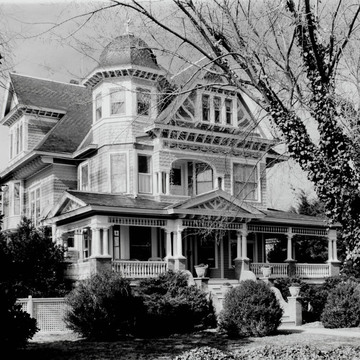Reedville was developed in the 1870s by a Maine sea captain, Elijah Reed, who established a fish-oil processing plant on the small peninsula. Reed came to the area in pursuit of a small, bony fish, the menhaden, which after the Civil War provided a replacement for whale oil. He and his family built a small town, based very much on a New England maritime model. It so prospered that by 1885 fifteen menhaden processing factories, now all destroyed, were located in the area. Hotels, a bank, and other structures joined the community. Reedville also attracted other industries and wealthy industrialists who constructed summer homes. These are clustered in a sort of “millionaires' row” near the apex of the point. George Reed, the son of Elijah, constructed his house (1897–1899; 77 Main Street), a large Queen Anne affair. Next door is the Gables, the Fisher house (1909; 76 Main Street), a brick Queen Anne. Opposite is Albert Morris's house (
PE24.1) (1900; 62 Main Street), which resembles some of the designs promoted by George Barber of
You are here
Reedville
VA 360 and VA 644 (Main St.)
If SAH Archipedia has been useful to you, please consider supporting it.
SAH Archipedia tells the story of the United States through its buildings, landscapes, and cities. This freely available resource empowers the public with authoritative knowledge that deepens their understanding and appreciation of the built environment. But the Society of Architectural Historians, which created SAH Archipedia with University of Virginia Press, needs your support to maintain the high-caliber research, writing, photography, cartography, editing, design, and programming that make SAH Archipedia a trusted online resource available to all who value the history of place, heritage tourism, and learning.














